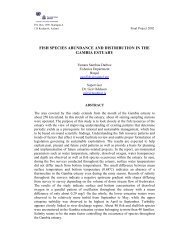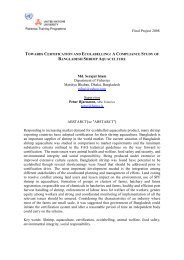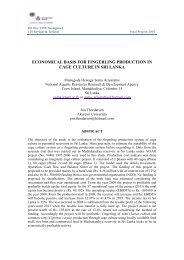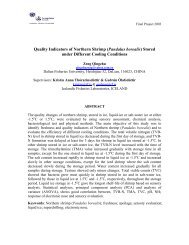Evaluation and Utilisation of Fish Protein Isolate Products
Evaluation and Utilisation of Fish Protein Isolate Products
Evaluation and Utilisation of Fish Protein Isolate Products
- No tags were found...
You also want an ePaper? Increase the reach of your titles
YUMPU automatically turns print PDFs into web optimized ePapers that Google loves.
Feng <strong>and</strong> Hultin (2001) also reported that extremes <strong>of</strong> pH can cause proteins to unfold <strong>and</strong>to increase their water binding.1.2 Rheological behaviour <strong>of</strong> FPSThe rheology <strong>of</strong> fish protein is evaluated because <strong>of</strong> its importance for the choice <strong>of</strong>formulation, process condition <strong>and</strong> quality control. From a technological point <strong>of</strong> viewrheological properties may give a quantitative contribution to texture characterisation <strong>and</strong>process control when using different formulation. Viscosity which is one <strong>of</strong> the mostcommon contributors to the texture <strong>of</strong> a semi-solid food or beverage measures a fluid ormaterial’s resistance to flow. According to Steffe (1996) fluids are classified into 2 groups;Newtonian <strong>and</strong> Non-Newtonian fluids. Newtonian fluids are those whose viscosity is notaffected by shear rate or time. Non-Newtonian fluids exhibit various degree <strong>of</strong> change withvarying levels <strong>of</strong> shear. They may also be time-dependent <strong>and</strong> are divided into two groups;thixotropic <strong>and</strong> rheopectic. A thixotropic (work s<strong>of</strong>tening) fluid decreases in viscosity astime is increased at a fixed (constant) rate <strong>of</strong> force or stress (Figure 1). A rheopectic (workhardening) fluid increases in viscosity as time is increased at a fixed (constant) rate <strong>of</strong>force (stress).Shear Stress (Brabender Unit)Time-Dependent BehaviourTime-independentThixotropicRheopecticTime at Constant Shear RateFigure 1 .Time-dependent behaviour <strong>of</strong> fluids (Adapted from: Steffe JF, 1996 )Mewis (1979) reported that both phenomena may be irreversible, reversible or partiallyreversible. There is general agreement that the term thixotropy refers to the time-dependentdecrease in viscosity, due to shearing, <strong>and</strong> the subsequent recovery <strong>of</strong> viscosity whenshearing is removed.Steffe (1996) reported that thixotropy in many fluid foods may be described in term <strong>of</strong> solgeltransition phenomenon <strong>and</strong> it could, apply for example, to starch-thickened baby foodor yogurt. After being manufactured <strong>and</strong> placed in a container, these foods slowly developa three dimensional network <strong>and</strong> may be described as a gel. When subjected to shear,structure is brocken down <strong>and</strong> the materials reach a minimum thickness where they exist inthe sol state. In foods that show reversibility, the network is rebuilt <strong>and</strong> the gel state reobtained.Irreversible materials remain in the sol state. When shear is removed, during the15
















